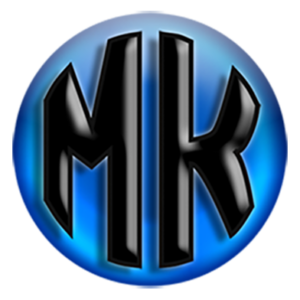The Rainbow Light Show
by Mary Ellen Bickford (2000)
It was a magical place and a magical time. It was 1981 and Norman Miller and I had rented a beautiful home in Santa Rosa, California where we would carry out the work of Rainbow Research, Inc. and present our increasingly popular multi-image shows. We called our new home the Lighthouse. For the shows, we hung a nine-foot by nine-foot rear-projection screen in the archway between the living room and dining room and created a theater environment with lots of chairs, pillows, and walls covered with original paintings and prints by the artists whose work we used in the shows.
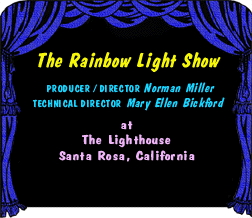
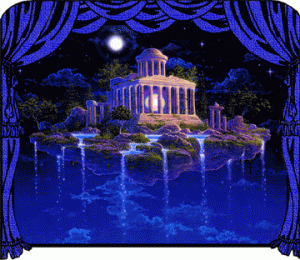
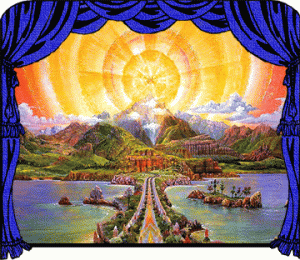
Every day we offered events for the public that were listed in our monthly newsletter and mailed to over 1,000 people. The newsletter also contained articles about the effects of color, light, and music. The highlight of our work at the Lighthouse took place five evenings a week when we presented the Rainbow Light Show — a 1-hour multiple-image show in seven sections, each focusing on one of the seven colors of the rainbow.
Each audio-visual section was focused on one of the seven energy centers of one’s physical body which are known to those who have explored their inner worlds as chakras. The music that we used along with the visuals “did the talking.” For this music, we used Pachelbel’s “Canon in D”, angelic music from our friends Iasos, Don Robertson and Manuel Göttsching, as well as music from Vangelis, Jon Anderson and The Alan Parsons Project. The amazing visuals were created by our visionary artist friends mixed with photographs of nature. Except for the song “Amazing Grace”, which we used for the opening of the 5th (throat) chakra, all of the music was instrumental. Since this energy center is in the throat chakra, we asked people sing along to activate that center. The mix of music, light, color, and images was an experience that assisted people in transcending into altered states of consciousness. Norman coined the term Electronic Alchemy for the experience, and it certainly was an alchemical experience for everyone.
Seminars
Seminars were held on the weekends and usually included the Rainbow Light Show. Presenters included many of the artists shown on this web page — talking about art as a form of healing and transformation. Many other authoritative people contributed to the seminars and work of Rainbow Research, Inc. We heard from Don Robertson, Iasos, Kip Sketcho, Constance Demby, Rowena Pattee Kryder, Peter Cady of Findhorn, Zenon, Peter Phelp, Marcel Vogel, Dale Walker, herbalist Charmoon Richardson, Christine Covington, artists Arwin and Wendy, Shivini Brun, John Hills, Steve Mangold, and more.
Subjects that were covered in the educational and experiential presentations included music, light, color, sacred symbology, sacred geometry, crystals, subtle forms of electromagnetic energy and healing through the arts. We researched how these subjects of interest affected humans, plants, and the environment.
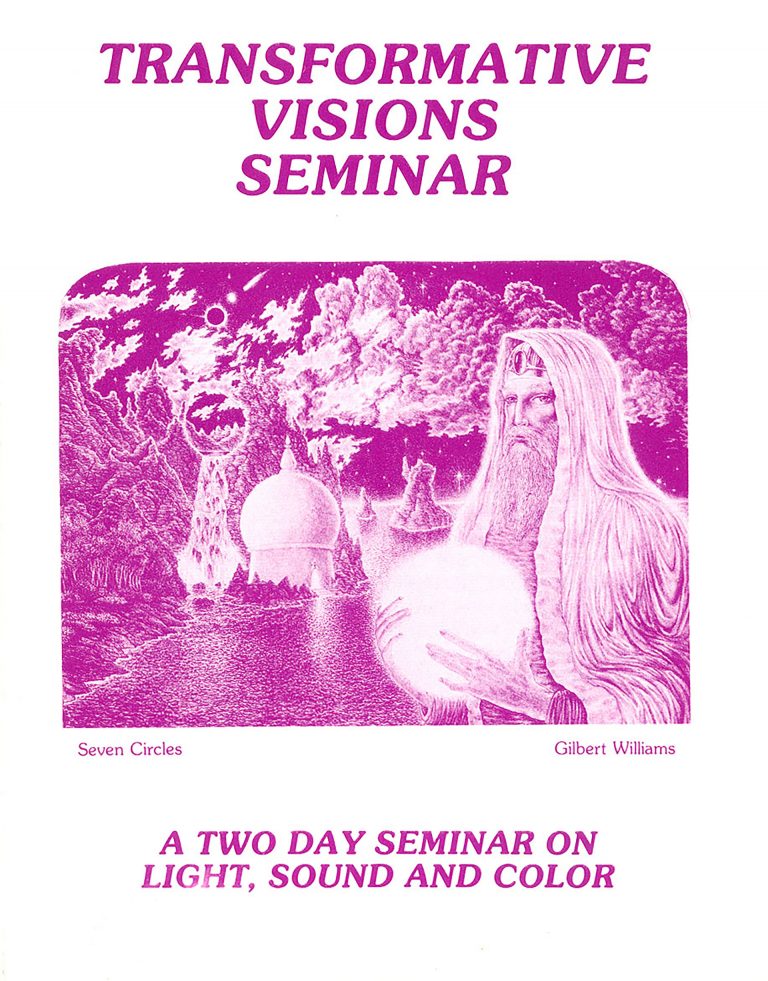
People who attended the shows and seminars came back again and again and usually brought several friends. Comments from attendees included a wide variety of positive personal experiences such as: they were more inspired, less stressed, happier, more motivated, and on and on.
Norman was reluctant to expose the behind-the-screens workings of what they saw until after the show. We didn’t want people to be in their minds during the show — it was truly an experience for the soul. But everyone asked —how’d you do that?
Norman Miller
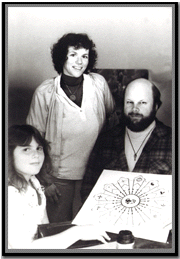
and Norman Miller (ca.1982)
Norman had begun his work with light in the 1960s, when he worked with the Garden of Delights Light Show. They were one of two major “in house” light shows at the Fillmore West in San Francisco who toured extensively with several rock groups from the bay area. Taking what he had learned from this work, he developed a show called The Evolution of the Mandala that mixed visionary art with visionary music and literally took people on a new journey into the world of archetypes, sacred symbolism, and transformative cutting-edge music. The Evolution of the Mandala was a forerunner to the Rainbow Light Show.
Plugged into a mixing board that Norman had especially designed and had been built by Neil Young’s sound engineer, Harry Sitham, the show was performed by hand to create a unique event each night. This real time symphony of light and color created an animated vision with images dissolving one into the other in a symphonic dance with the music.
Working with Kids
Children of today are the leaders of the future of our world. I believe that if you want to make healthy changes in the world, you must teach the children about the arts and how important music and positive imagery are in forming the consciousness of humanity and healing traumas of the past.
I had a dream while living at the Lighthouse, where I was teaching children about all the power of the arts and saw them producing a multi-image show. The dream affected me so that I ran an ad in the newspaper inviting kids to produce their own show. The ad attracted a class of eager students. Using Rainbow Research’s extensive slide library, studio, and Norman’s coaching, I helped the kids focus on a subject for their show. They chose from several nominated ideas, and we produced I Want to Live — in Peace, a show that featured the music of John Denver. What a show! This three-minute piece was added to the beginning of the Rainbow Light Show, and it always brought our audiences to tears. With their emotions opened, people were hugging and crying and clapping. Wow! Leave it to the kids! Now, we all were seeing the show through the eyes of the child!
Future Quest
Over a two-year period, we grew rapidly. It was difficult to count the number of people who attended since so many were repeat viewers, but I think it is safe to say that some 10,000 people flowed through our doors. The shows grew out of the theater room in our home and into rented auditoriums, and that grew too. Norman and I realized that the show needed to find a home where it could run every hour and perhaps even in multiple locations. We met with a planetarium director in Denver, Colorado who loved the idea of presenting the Rainbow Light Show in his space, but he said it would work best in the IMAX film format and introduced us to MacGillivray Freeman Films.
We met with Greg MacGillivray in Laguna Beach, California. He too loved the ideas, and off we went to bring together the people and resources to produce a film that we decided to call Future Quest. Imagine all this beautiful artwork on the IMAX screen! We were excited!
Walt Disney had been our inspiration. His 1939 film Fantasia was to us the best example of mixing music and beautiful images in perfect timing. Being visionaries, Norman and I could see the potential of opening people to the experience of beauty through the advanced technology of the day. Never had all technologies been brought together to furnish a mass audience with a consciousness-expanding motion picture such as we knew we could produce.
I started bringing together people who were interested in our new IMAX Future Quest project. We met with Academy Award-winning, special-effects wizard Richard Edlund, and with Hugo Zuccarelli, the inventor of holophonic sound. The award-winning sound-effects expert Frank Serafine was also on board, and we explored the then-new science of Motion Capture Technology, and many other technologies as well — taking Walt Disney’s ideas into the future. Everyone was excited and ready to come on board when we were ready.
As fate would have it — I was in the fast lane on my way to one of our meetings with film industry people when a front tire flew off my car. My injuries left me in a struggle for my own survival. After a long fight to overcome the pain from a fractured neck, I surrendered and bowed out of the project. Now, a few decades later, I can still see the potential of our dreams — not yet achieved or attempted by anyone. I have adjusted to my limitations and continue to develop projects that integrate what I have learned into today’s media.
Now, more than ever, the world needs healing, and the children need the tools to survive the future on our planet. I believe that the best tools we can have in our bag of resources are strong spirits and open hearts. Everyone needs to have a dream and the motivation and support to fulfill their purpose for being. God bless the world!
